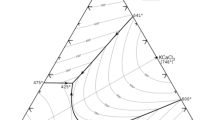Abstract
The selective dissolution of brass was studied using potentiodynamic polarization, coloumetric analysis and electrochemical impedance spectroscopy (EIS). Using coloumetric analysis, the partial currents i Zn and i Cu were measured under various potentials and chloride concentrations. Chloride ions promote the dissolution of Zn and Cu and hence increase the rate of dissolution of the alloy. At active potentials, zinc dissolves preferentially leaving the alloy surface enriched in copper. Under this condition, the polarization resistance of the interface and its double layer capacity increase with the time and extent of dissolution of the alloy. As the chloride concentration increases and/or the potential shifts in the noble direction, the rate of copper dissolution increases so that simultaneous dissolution of both components is observed. This increase in the rate of copper dissolution is enhanced by the higher stability of the copper chloride complex (CuCl2 −) compared to zinc chloride (ZnCl2).
Similar content being viewed by others
References
W. Pickering, Corros. Sci. 23 (1983) 1107.
H. Kaiser, in F. Mansfield (Ed), ‘Alloy Dissolution in Corrosion Mechanisms’ (Marcel Dekker, New York, 1987), p. 85.
C. van Orden, in R. Baboian (Ed), ‘Corrosion Tests and Standards: Application and Interpretation’ (ASTM 28-020095-27 (ASTM, Philadelphia, PA, 1995).
M.G. Fontana, ‘Corrosion Engineering’ (McGraw-Hill, New York, 3rd edn, 1986), p.86.
D.A. Jones, ‘Principles and Prevention of Corrosion’ (Prentice-Hall, Englewood Cliffs, NJ 2nd edn, 1996), p. 20.
N.W. Polan, in ‘Metals Handbook, Corrosion, Vol. 13’ (ASM International, Materials Park, OH, 9th edn, 1987).
Z. Liu, L. Lin, J. Xu and Y. Zhao, Chin. J. Mater. Res. (China) 14 (2000) 145.
L. Burzynska, Corros. Sci. 43 (2001) 1053.
A.A. Elwarraky, J. Mater. Sci. 31 (1196) 119.
R.K. Diannappa and S.M. Mayanna, Corros. Sci. 27 (1987) 349.
I. Singh, 'Anti-Corrosion, (March 1988), p. 4.
H.W. Pickering and P.J. Byrne, J. Electrochem. Soc. 116 (1969) 1492; 118 (1971) 209.
G.T. Burstein and G. Gao, J. Electrochem. Soc. 141 (1994) 912.
H. Martin, P. Carro, A. Hernandez Creus, J. Fernandez, P. Esparza, S. Gonzalez, R.C. Salvarezza and A.J. Arvia, J. Phys. Chem. 104B (2000) 8229.
C.E. Price, Mater. Perform. 34 (1995) 87.
A.M. Fenelon and C.B.B. Breslin, J. Appl. Electrochem. 31 (2001) 509.
K. Balakrishnan and V.K. Venkatesan, Werkst. Korros. 29 (1978) 113.
V.N. Chervyakov, A.P. Pchel'nikov and V.V. Losev, Elektrokhimiya (Russia) 27 (1991) 1647.
H.M. Shalaby, A. Al-Hashem, M. Lowther and J. Al-Besharah (Eds), ‘Industrial Corrosion and Corrosion Control Technology’ (Kuwait Institute for Scientific Research, Kuwait, 1996).
Samuel J. Lawrence and Richard L. Bodnar, Adv. Mater. Proces. (Feb. 1997) 29.
N. De Zoubov, C. Vanleugenhaghe and M. Pourbaix, in M. Pourbaix (Ed), ‘Atlas of Electrochemical Equilibria in Aqueous Media' (NACE, Houston, 1974), p. 384.
N. De Zoulov and M. Pourbaix, in[21], p. 406.
M.E. Walton and P.A. Brook, Corros. Sci. 17 (1977) 593.
L.H. Jenkins, J. Electrochem. Soc. 117 (1970) 630.
A.L. Bacarella and J.C. Griess, J. Electrochem. Soc. 120 (1973) 459.
J.O'M. Bockris, B.T. Rubin, A. Despic and B. Lovrecek, Electrochim. Acta 17 (1972) 973.
C. Kato, B.G. Ateya, J.E. Castle and H.W. Pickering, J. Electrochem. Soc. 127 (1980) 1881.
C.H. Bonfiglio, A.C. Albaya and A.O. Cobo, Corros. Sci. 13 (1973) 717.
D. Tromans and G. Li, Electrochem. Sol. St. Lett. 5 (2002) B5.
J.A. Dean, (Ed), ‘Lange’s Handbook of Chemistry’ (McGraw-Hill, New York, 14th edn, 1992), p. 8.83.
F.M. Al-Kharafi and B.G. Ateya, J. Electrochem. Soc. 149 (2002) B206.
H.W. Pickering, J. Electrochem. Soc. 115 (1968) 690.
Author information
Authors and Affiliations
Corresponding author
Rights and permissions
About this article
Cite this article
Al-Kharafi, F., Ateya, B. & Allah, R.A. Selective dissolution of brass in salt water. Journal of Applied Electrochemistry 34, 47–53 (2004). https://doi.org/10.1023/B:JACH.0000005616.41240.d0
Issue Date:
DOI: https://doi.org/10.1023/B:JACH.0000005616.41240.d0




